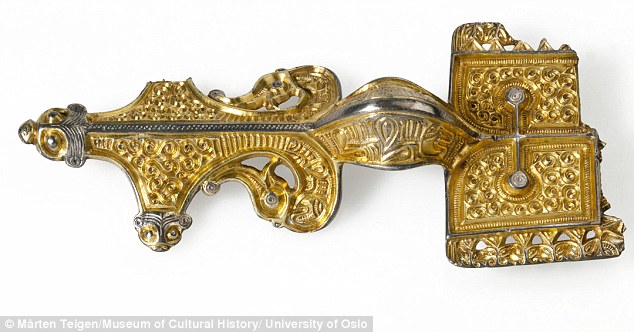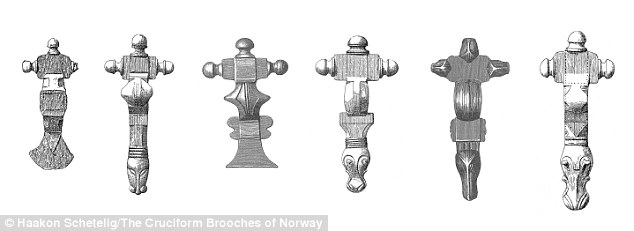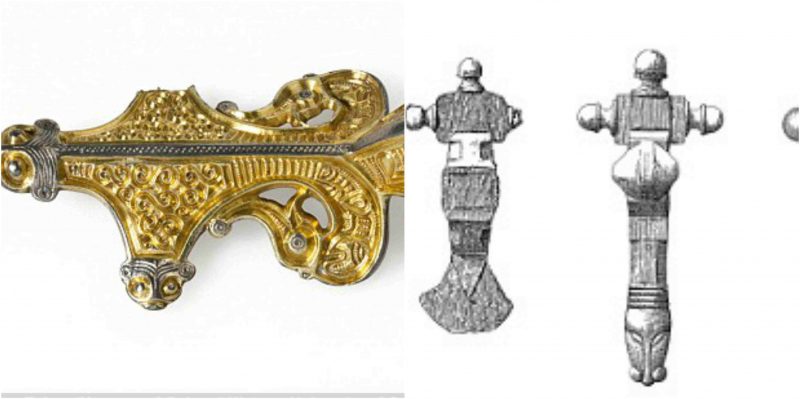Vikings are best known for their ferocious warriors who terrorized much of Europe throughout the Middle ages. They have a well earned reputation for raping and pillaging their way through the continent. It turns out, as researchers have discovered that the Vikings liked to show off their ill-gotten gold by adorning themselves with bling.
Recently, archaeologists have discovered evidence that some women from Norway during the Iron Age (about 1,500 years ago) wore jewelry that was emblazoned with “foreign” designs, the purpose of which was to help the women stand out from their peers. This society, which thrived around 500 AD, was a combination of Sami cultures and North-Germanic Norse, the group from which the Vikings would later emerge in the 8th century. According to researchers, the Vikings continued the tradition of wearing jewelry as a social statement.
In the pre-Viking society, the women who wore jewelry with the foreign designs mostly belonged to the upper echelons. This makes sense, as they would be able to afford such luxuries. There are other reasons, however, that the upper classes would wear such jewelry. Dr. Ingunn Marit Røstad, an archaeologist at the Museum of Cultural History in Oslo, explained that clothing and jewelry choices that people made were governed by strict cultural rules.

She said, “It’s not at all likely that you could choose freely to wear whatever jewelry you liked or wanted to wear in the migration period/Scandinavian Iron Age. Your “choice” was governed or structured or regulated by unwritten laws about social dress codes.” Dr. Røstad added that the women who wore foreign jewelry did so as a conscious expression of foreign affiliations that would give them and their families status among their neighbors.
“I think the owners were women belonging to the upper strata of society, although perhaps not exclusively the uppermost level.” She continued, “Most of these finds definitely belong to the richest graves in this period — the migration period, c. AD 400-550 — but others have been found in graves that are well furnished, but would not be characterized as “aristocratic”. I think that the foreign or “different” jewelry gave social status both to the women that wore the jewelry and to their family.”
On top of that, Dr. Røstad believes the mixed jewelry may have been worn as an attempt to demonstrate political alliances. During an interview with Science Nordic, she said that by the 6th century, it was customary for the upper classes to raise each other’s children, and that this would have given the families connections to distant regions. They then would have tried to display these connections by combining the jewelry and clothing of the different lands.
Dr. Røstad has examined around 1,200 Iron Age brooches and pieces of jewelry (all dating between 400 and 550 AD and found in graves) that were found in several different areas of Norway. She found while most of the jewelry appeared to conform with the styles of the local areas they were found in, around twenty-five pieces appeared to be quite different. They seemed to combine local designs with those more commonly seen in Denmark and southern Sweden.
For example, one artifact is a gilded silver brooch that was found in the Skien area of Norway and has spiral decorations that were more commonly seen in Denmark or Sweden. In another example, archaeologists found a mold in eastern Sweden that could have been used to make jewelry typically seen in Rogaland, western Norway.

When the Viking society emerged, they carried on this custom of using jewelry to make statements about their social status. Dr. Røstad told Science Nordic, “I am convinced that this represents a desire to stand out.” It was more common during the Viking Age (around 790 AD) to see jewelry and clothing that mixed designed from different regions. This makes sense, as the Vikings traveled far and wide in their raids. Before that, however, it was very rare to find such mixtures.
One of the sites that has been a veritable treasure trove is the 1,500-year-old village unearthed. Located in the middle of Norway’s Ørland Peninsula and covering an area of more than twenty-two acres (nine hectares) the site was once an early Viking settlement. Experts have been investigating the site because of plans to extend a military airbase there. The future airbase is being designed to accommodate a fleet of fifty-two new F-35 jet fighters. The location of the village was intentionally chosen due to its strategic importance, which is why the airbase is being expanded into the area.
The site has yielded many Viking artifacts, and the remains of several traditional Viking long houses have been recovered too. One such discovery are delicate blue and amber beads—these suggest, archeologists said, that the inhabitants used their position to build up wealth and weren’t afraid to display it.
Dr. Røstad cautioned people against comparing these ancient societies with modern hipsters, who build their wardrobe around a desire to not conform to the society around them. “I don’t really think we can compare them to the “hipsters”, because today everybody can choose to become a hipster.” She explained, “But there is no doubt that both in the Iron Age and today people use dress and jewelry to distinguish themselves and make social statements.”
